The state of surveillance: at Ikon Gallery Mahtab Hussain considers Birmingham’s
Muslim community & architecture
British artist & photographer Mahtab Hussain presents a
series of new works co-commissioned by Birmingham’s Ikon Gallery & Photoworks exploring
representation and surveillance among the Muslim community in Britain,
rendering a larger portrait of the nation’s migrant history. Anmol Ahuja visited
the exhibition & observes the distinctly spatial notions of that memory &
strife.
Amid an increasingly dubious socio-political climate of
inequality that systematically disfavours minorities across the world, Mahtab
Hussain’s work for his solo show What Did You Want To See? is a timely
parable of resistance and the inherent hope it harbours – even against great
odds. These ‘great odds’ –
aptly
summarised in Alberto Toscano’s 2023 book,
Late
Fascism: Race, Capitalism and the Politics of Crisis, for one – continue
underlining and defining the experiences of diaspora and coloured communities
well into present day accounts, wherein questions of identity, belonging, and
even survival are soldered into a sense of being and living for these
communities. Hussain’s work is as much a reflection of this collective,
definitive experience, as it is a reaction to the travails afforded by it. It
is equal parts solidarity and rage; contemplation and declaration.
![]()
![]()
![]()
For Hussain, who I serendipitously caught by a recessed archway at Ikon Gallery’s foyer before his show’s opening, and whose work has been guided by the predicament of toeing the British Muslim identity, documenting and producing these works far superseded an expression of angst from years of discrimination directed towards the Muslim community in the UK at large; but especially in Birmingham, where roughly 30% of the population identifies as Muslim. Hussain spoke about his humble beginnings and creative leanings as a Glasgow-born child of first-generation immigrants from Pakistan and India, solemnly believing in art, expression, and the beauty of shared traditions and community as counterculture and tools with which to navigate the proverbial tryst with identity in foreign lands.
While sensitively confiding about his experiences of growing up amid racial tensions and rampant Islamophobia and xenophobia – not an entirely uncommon experience for brown people in the UK in both subtle and unsubtle ways – his reinforcement of the idea of an abundance to dismantle scarcity driven fear and hate via capitalist and state machineries ended up shaping my chief takeaways from the show. “There’s enough for all of us,” Hussain stated, solemnly, at the end of our chat.
![]()
![]()
![]()
![]()
![]()
![]()
![]()
Taking over the gallery’s second floor the co-commission with Photoworks includes works spanning several mediums, with Hussain’s photography and portraiture taking centre stage in arresting ways. A 16x10 grid of postcard-sized photographs, part of a systematic documentation regimen by Hussain capturing 160 Birmingham mosques, is a visitor’s first visual encounter in the gallery. Apart from shining a light on the diversity of mosque architecture in the city (and broadly across the UK), the photographs attempt to reclaim both narratives and perspectives that would view these sites as places to be surveilled and monitored.
Hussain captures the mosques with a reverence that is not lost on the viewer – a reverence which may bear attribution to the sacred, but where the humane also shines through. The ground line or threshold of the street in these photographs, for instance, is a fixed, almost insistent presence. It is an unyielding foreground that firmly positions both the viewer and the documenter at ground level, as opposed to a god’s eye vantage afforded by CCTV or satellite equipment.
![]()
![]()
![]()
The architectural language of purpose-built mosques across Birmingham, including instantly recognisable structures such as the Birmingham Central Mosque, Faizal Islam Masjid, and Al Masjid Al Saifee, is evocative of notions of iconicity and an understated grandeur, flaunting Islamic art and architecture motifs. However, a majority of mosques in the armada of Hussain’s photographs aren’t purpose built at all; they are spaces that have been adapted, reused, appropriated – a hybrid of style, convenience, and availability of space. Between inconspicuous shop fronts, residences, and repurposed churches, it is almost as if a new typology of architecture, of resistance develops, one that speaks directly to the adaptability and hybridity of the immigrant and diaspora experience itself.
Reclaiming prevalent narratives and flipping the gaze is quintessential to how these works are read and perceived, according to Hussain. So, while spatial appropriation and reappropriation of congregational and community spaces – especially religious – continues being equated to encroachment and being denigrated as parasitic, it remains a tool of methodic resistance, and in most cases, simply existence. After all, making or holding space in the face of oppression has been an act of resistance and positing a declaration of their existence for historically othered communities, as in the case of Palestinians and Sumud. Elsewhere in the gallery, it is these spatial motifs and reminiscent iconography that aid the transformation of blank space into one for congregation and prayer, as an embellished carpet and latticed screen invite viewers to participate in prayer or observe.
![]()
![]()
![]()
![]()
The biggest space in the gallery has its walls adorned by a series of black and white portrait photographs by Hussain where the reversal of the gaze is perhaps at its most piercing. The subject of Hussain’s portraits are everyday people from the city, but far from muting their stances or gestures into the submission of everyday-ness, they gaze right back at you. It isn’t an indifferent gaze either, but at the centre of that room, their convergence is bound to gauge a visceral reaction from the viewer. From a woman in a burqa with only her eyes visible, to an elderly man in traditional attire and Hussain’s own mother posing with a cigarette, the diversity of subjects, like the mosques, begs to be seen as secondary to their defiant existence.
![]()
![]()
![]()
A number of installations append Hussain’s photographic displays. A short film made in collaboration with video artist Guy Gunaratne uses archival footage to chronicle the Muslim experience in Britain over decades, complete with police clashes, community resistance against unlawful surveillance, and Nigel Farage’s Reform hate speeches. There are glimmers of hope to be found in this deeply affecting work; in shared joy and care, and in shots that showcase how the community remains more than its history and singular profiling and stereotyping. At the same time though, the screening room is earmarked with placards proclaiming “I am not a terrorist,” “I am not a Jihadist,” “I am not a radical,” and “I am not a Paki” outlining an allied installation by Hussain, An Act of Civil Declaration (2025). Foregrounded against some distressing visuals and sounds from the film, it’s only suitable that these proclamations remain voiceless, attributing the tonality of reading them to the viewer.
There is a particularly interesting observation in the linguistic musing behind What Did You Want To See?, in ways that its deconstruction with emphasis on certain words will yield different perspectives with which to view the exhibition and Hussain’s absolutely remarkable work here. Subject, object, photographer, and their intentions, along with prejudices and inhibitions, are all called into question, decrying the futility of the gaze. What did you want to see, and did you find it?
![]()
![]()
![]()
In 2007, West Midlands Police created Project Champion, a CCTV network designed to capture individuals and vehicle data around the Alum Rock and Sparkhill areas of Birmingham. Their dubious propositions to disproportionately surveil and curtail the freedoms of these Muslim neighbourhoods in Birmingham, widely rigged with surveillance cameras, were opposed by the community with the removal of the network in 2010. The extraction of the cameras left their marks on the roads, and also onto the lives of people forced into conformity for fear of being watched. What did you want to see, and are you intent upon finding it? Will you leave without it?
![]()
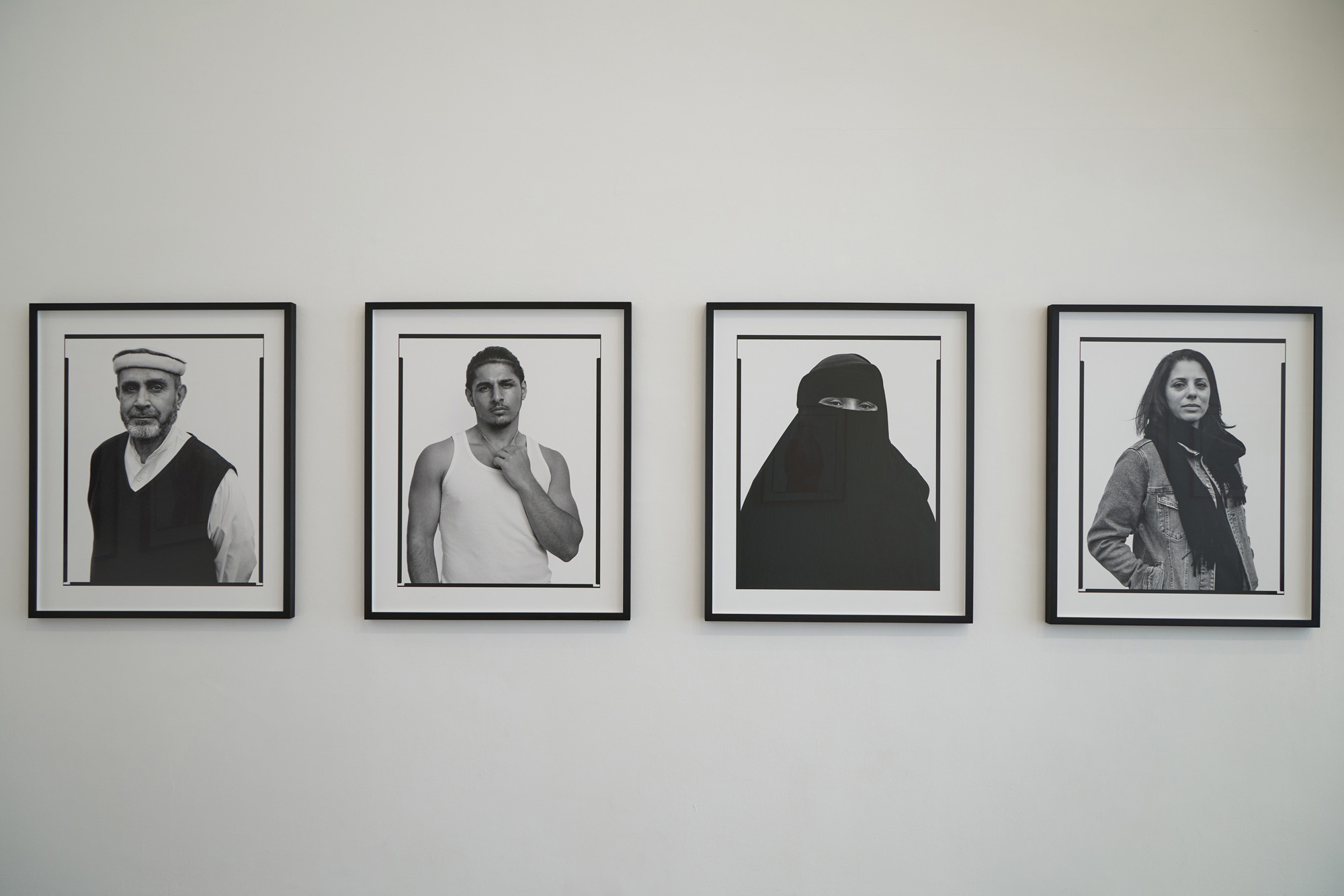

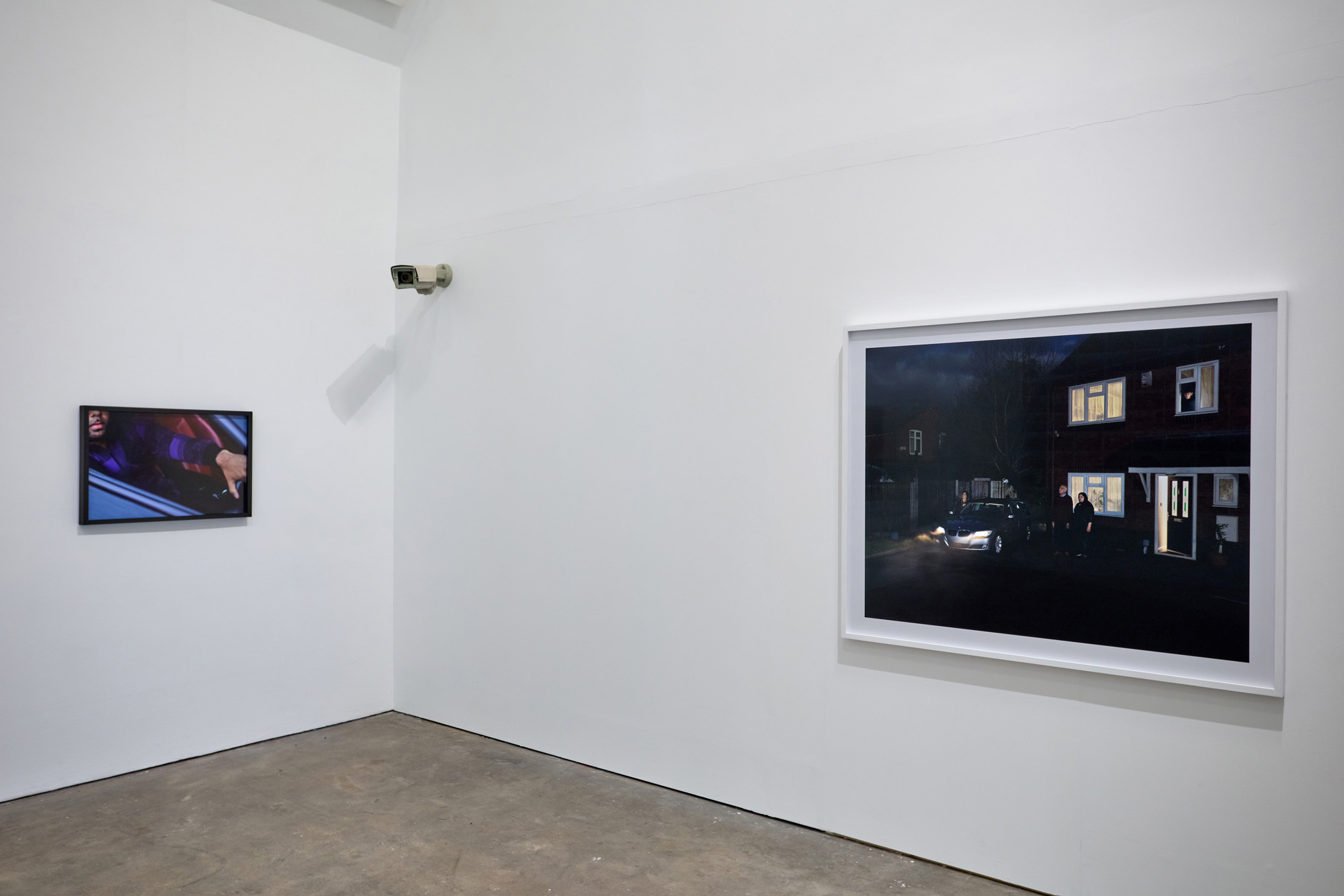
figs.i-iii
For Hussain, who I serendipitously caught by a recessed archway at Ikon Gallery’s foyer before his show’s opening, and whose work has been guided by the predicament of toeing the British Muslim identity, documenting and producing these works far superseded an expression of angst from years of discrimination directed towards the Muslim community in the UK at large; but especially in Birmingham, where roughly 30% of the population identifies as Muslim. Hussain spoke about his humble beginnings and creative leanings as a Glasgow-born child of first-generation immigrants from Pakistan and India, solemnly believing in art, expression, and the beauty of shared traditions and community as counterculture and tools with which to navigate the proverbial tryst with identity in foreign lands.
While sensitively confiding about his experiences of growing up amid racial tensions and rampant Islamophobia and xenophobia – not an entirely uncommon experience for brown people in the UK in both subtle and unsubtle ways – his reinforcement of the idea of an abundance to dismantle scarcity driven fear and hate via capitalist and state machineries ended up shaping my chief takeaways from the show. “There’s enough for all of us,” Hussain stated, solemnly, at the end of our chat.







figs.iv-x
Taking over the gallery’s second floor the co-commission with Photoworks includes works spanning several mediums, with Hussain’s photography and portraiture taking centre stage in arresting ways. A 16x10 grid of postcard-sized photographs, part of a systematic documentation regimen by Hussain capturing 160 Birmingham mosques, is a visitor’s first visual encounter in the gallery. Apart from shining a light on the diversity of mosque architecture in the city (and broadly across the UK), the photographs attempt to reclaim both narratives and perspectives that would view these sites as places to be surveilled and monitored.
Hussain captures the mosques with a reverence that is not lost on the viewer – a reverence which may bear attribution to the sacred, but where the humane also shines through. The ground line or threshold of the street in these photographs, for instance, is a fixed, almost insistent presence. It is an unyielding foreground that firmly positions both the viewer and the documenter at ground level, as opposed to a god’s eye vantage afforded by CCTV or satellite equipment.



figs.xi-xiii
The architectural language of purpose-built mosques across Birmingham, including instantly recognisable structures such as the Birmingham Central Mosque, Faizal Islam Masjid, and Al Masjid Al Saifee, is evocative of notions of iconicity and an understated grandeur, flaunting Islamic art and architecture motifs. However, a majority of mosques in the armada of Hussain’s photographs aren’t purpose built at all; they are spaces that have been adapted, reused, appropriated – a hybrid of style, convenience, and availability of space. Between inconspicuous shop fronts, residences, and repurposed churches, it is almost as if a new typology of architecture, of resistance develops, one that speaks directly to the adaptability and hybridity of the immigrant and diaspora experience itself.
Reclaiming prevalent narratives and flipping the gaze is quintessential to how these works are read and perceived, according to Hussain. So, while spatial appropriation and reappropriation of congregational and community spaces – especially religious – continues being equated to encroachment and being denigrated as parasitic, it remains a tool of methodic resistance, and in most cases, simply existence. After all, making or holding space in the face of oppression has been an act of resistance and positing a declaration of their existence for historically othered communities, as in the case of Palestinians and Sumud. Elsewhere in the gallery, it is these spatial motifs and reminiscent iconography that aid the transformation of blank space into one for congregation and prayer, as an embellished carpet and latticed screen invite viewers to participate in prayer or observe.
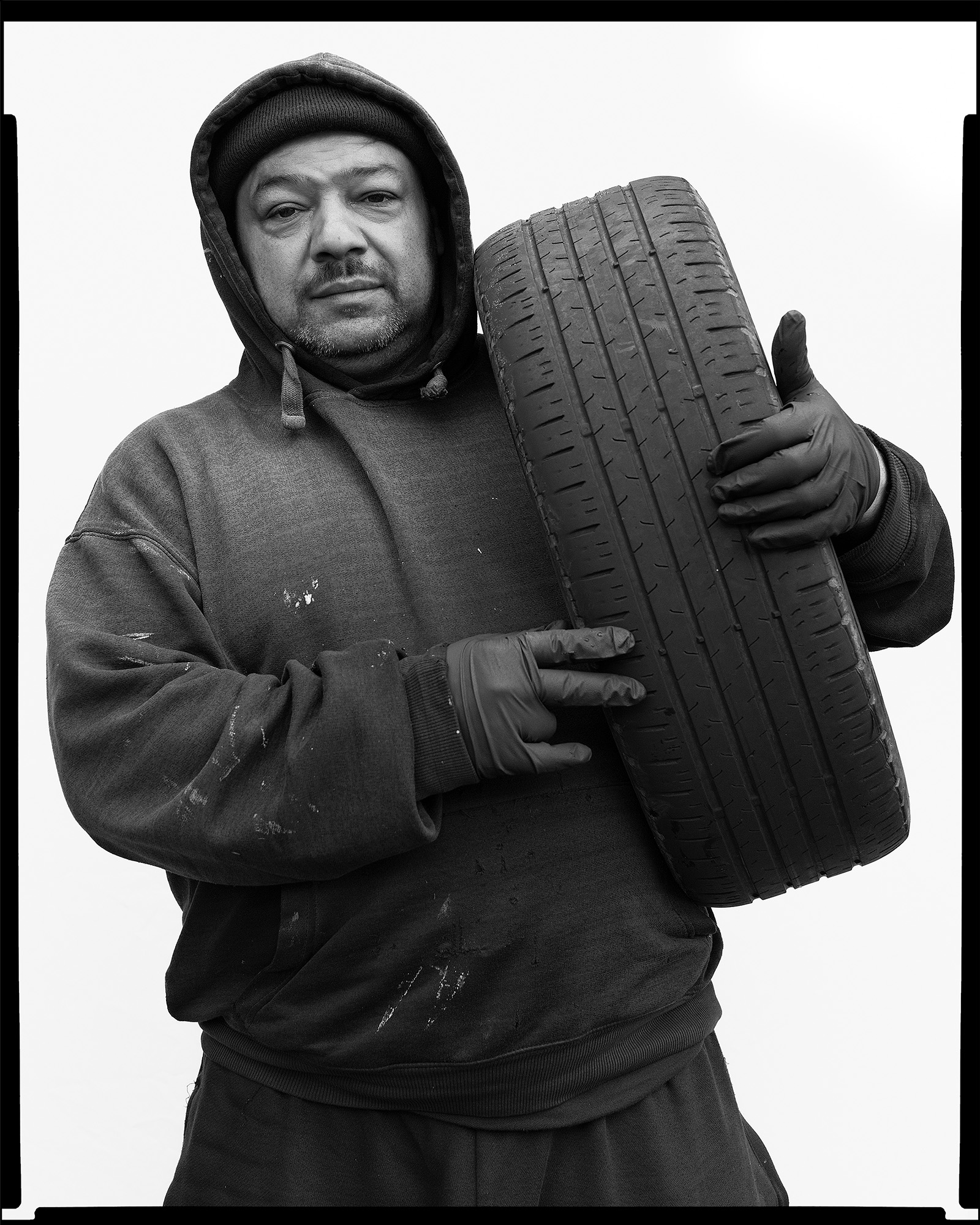



figs.xiv-xvii
The biggest space in the gallery has its walls adorned by a series of black and white portrait photographs by Hussain where the reversal of the gaze is perhaps at its most piercing. The subject of Hussain’s portraits are everyday people from the city, but far from muting their stances or gestures into the submission of everyday-ness, they gaze right back at you. It isn’t an indifferent gaze either, but at the centre of that room, their convergence is bound to gauge a visceral reaction from the viewer. From a woman in a burqa with only her eyes visible, to an elderly man in traditional attire and Hussain’s own mother posing with a cigarette, the diversity of subjects, like the mosques, begs to be seen as secondary to their defiant existence.



figs.xviii-xx
A number of installations append Hussain’s photographic displays. A short film made in collaboration with video artist Guy Gunaratne uses archival footage to chronicle the Muslim experience in Britain over decades, complete with police clashes, community resistance against unlawful surveillance, and Nigel Farage’s Reform hate speeches. There are glimmers of hope to be found in this deeply affecting work; in shared joy and care, and in shots that showcase how the community remains more than its history and singular profiling and stereotyping. At the same time though, the screening room is earmarked with placards proclaiming “I am not a terrorist,” “I am not a Jihadist,” “I am not a radical,” and “I am not a Paki” outlining an allied installation by Hussain, An Act of Civil Declaration (2025). Foregrounded against some distressing visuals and sounds from the film, it’s only suitable that these proclamations remain voiceless, attributing the tonality of reading them to the viewer.
There is a particularly interesting observation in the linguistic musing behind What Did You Want To See?, in ways that its deconstruction with emphasis on certain words will yield different perspectives with which to view the exhibition and Hussain’s absolutely remarkable work here. Subject, object, photographer, and their intentions, along with prejudices and inhibitions, are all called into question, decrying the futility of the gaze. What did you want to see, and did you find it?
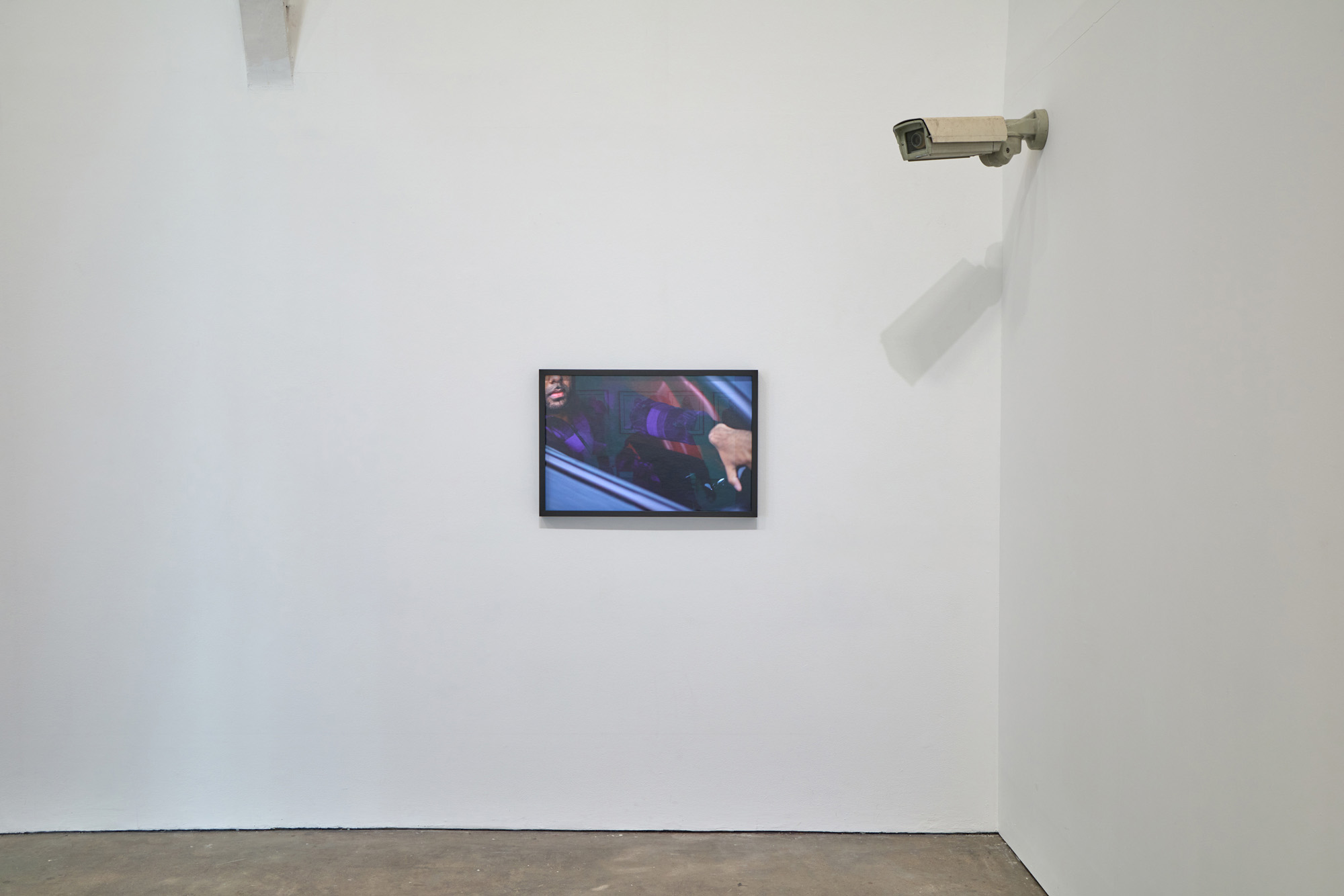

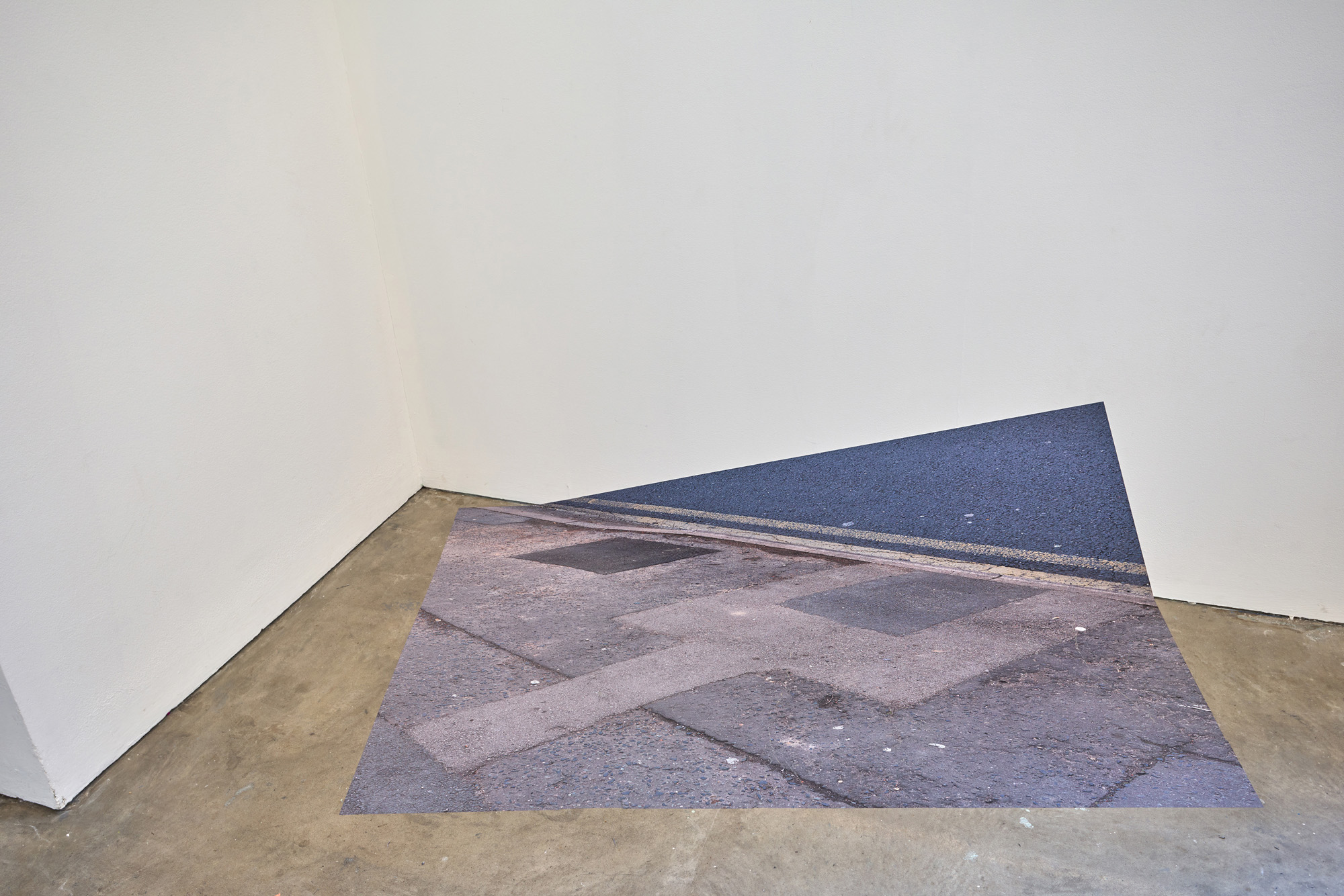
figs.xxi-xxiii
In 2007, West Midlands Police created Project Champion, a CCTV network designed to capture individuals and vehicle data around the Alum Rock and Sparkhill areas of Birmingham. Their dubious propositions to disproportionately surveil and curtail the freedoms of these Muslim neighbourhoods in Birmingham, widely rigged with surveillance cameras, were opposed by the community with the removal of the network in 2010. The extraction of the cameras left their marks on the roads, and also onto the lives of people forced into conformity for fear of being watched. What did you want to see, and are you intent upon finding it? Will you leave without it?

fig.xxiv
Mahtab Hussain (b. 1981) explores the important relationship between identity, heritage and displacement. Hussain’s You Get Me? series debut in the UK at Autograph ABP, London in 2017, curated by Mark Sealy, it reached an audience in excess of 2m through print, online coverage, TV, and radio with prominent featured articles The Guardian, The Economist, The Independent, Vanity Fair, New York Time, Metro, Buzzfeed, Dazed and Confused. He received his BA in History of Art at Goldsmith College specialising in Fine Art Photography; his MA in Museum and Gallery Management, City University, London; awarded an Arts Humanities Research Council (AHRC), he completed a MA in Photography at Nottingham Trent University.
www.mahtabhussain.com
Anmol Ahuja is a London-based writer, editor & novice academic with over eight years of multidisciplinary experience spanning core & allied disciplines in architecture & design. He is currently Features Editor at STIR, where he steers the platform’s editorial across the architecture & design verticals, geared towards intertwining theory & practice with a keen sense of questioning & responsible journalism in creative disciplines. His work & academic enquiry revolve around post- & de-colonial theory, housing, the democracy of access in architecture & design, ideas of labour in the profession, climate justice & more, while cinema & its relationship to space continue to fascinate him personally. He has an MA in History & Critical Thinking from the AA School, London.
www.stirworld.com/author-Anmol-Ahuja
www.stirworld.com/author-Anmol-Ahuja
visit
Mahtab Hussain, What Did You Want To See?, a co-commission & co-curation with Photoworks, is on at Ikon Gallery, Birmingham, until 01 June. Further information available at: www.ikon-gallery.org/exhibition/mahtab-hussain-what-did-you-want-to-see
Mahtab Hussain has also designed a new bench in London’s Queen Elizabeth Park as part of The Line’s 10th anniversary programme. Please Take a Seat is a contemporary reinterpritation of a Victorian park bench exploring the relationship between identity, heritage & dispacement. Further information & the bench’s location can be found at: www.the-line.org/artist/mahtab-hussain
images
figs.i,iii,xi,xii,xviii-xxi,xxiii Mahtab Hussain, What
Did You Want To See? Installation view, Ikon Gallery (2025). Image courtesy
Ikon. Photo by David Rowan.
fig.ii Mahtab Hussain,
Birmingham Central Mosque, Birmingham (2024). From the series What Did You Want To See? (2024), Digital C - Type print,
Courtesy Mahtab Hussain.
fig.iv Mahtab Hussain,
Masjid Yousuf, Birmingham (2024). From the series What Did You Want To See? (2024), Digital C - Type print,
Courtesy Mahtab Hussain.
fig.v Mahtab Hussain,
Raza Mosque, Birmingham (2024). From the series What Did You Want To See? (2024), Digital C - Type print,
Courtesy Mahtab Hussain.
fig.vi Mahtab Hussain,
Jamia Mosque, Birmingham (2024). From the series What Did You Want To See? (2024), Digital C - Type print,
Courtesy Mahtab Hussain.
fig.vii Mahtab Hussain, East Birmingham Central Masjid, Birmingham (2024). From the series What Did You Want To See? (2024), Digital C - Type print,
Courtesy Mahtab Hussain.
fig.viii Mahtab Hussain,
Faizal Islam Masjid, Birmingham (2024). From the series What Did You Want To See? (2024), Digital C - Type print,
Courtesy Mahtab Hussain.
fig.ix Mahtab Hussain,
Green Lane Masjid, Birmingham (2024). From the series What Did You Want To See? (2024), Digital C - Type print,
Courtesy Mahtab Hussain.
fig.x Mahtab Hussain,
Al Masjid Al Saifee, Birmingham (2024). From the series What Did You Want To See? (2024), Digital C - Type print,
Courtesy Mahtab Hussain.
fig.xiii Mahtab Hussain,
Gulzar-E-Madina, Birmingham (2024). From the series What Did You Want To See? (2024), Digital C - Type print,
Courtesy Mahtab Hussain.
fig.xiv Mahtab Hussain,
Daddy Shaf (2024). From the series What Did You Want To See? (2024), Digital C - Type print,
Courtesy Mahtab Hussain.
fig.xv Mahtab Hussain,
Imtiaz (2024). From the series What Did You Want To See? (2024), Digital C - Type print,
Courtesy Mahtab Hussain.
fig.xvi Mahtab Hussain,
Alisha (2024). From the series What Did You Want To See? (2024), Digital C - Type print,
Courtesy Mahtab Hussain.
fig.xvii Mahtab Hussain,
Aqeel (2024). From the series What Did You Want To See? (2024), Digital C - Type print,
Courtesy Mahtab Hussain.
fig.xxii Mahtab Hussain, Car drivers were monitored via ANPR Cameras (2010). From the series What Did You Want To See? (2024), Digital C - Type print,
Courtesy Mahtab Hussain.
fig.xxiv TheLine, Mahtab Hussain, Please Take a Seat (2025). Queen Elizabeth Olympic Park, The Line. Photo
©
Laura Hodgson.
publication date
08 April 2025
tags
Adaption, Anmol Ahuja, Bench, Birmingham, Camera, CCTV, Documentation, Guy Gunaratne, Ikon Gallery, Islamophobia, Mahtab Hussain, Mosque, Muslim, Photography, Police, Queen Elizabeth Park, Surveillance, The Line, Alberto Toscano, West Midlands Police
Mahtab Hussain has also designed a new bench in London’s Queen Elizabeth Park as part of The Line’s 10th anniversary programme. Please Take a Seat is a contemporary reinterpritation of a Victorian park bench exploring the relationship between identity, heritage & dispacement. Further information & the bench’s location can be found at: www.the-line.org/artist/mahtab-hussain


